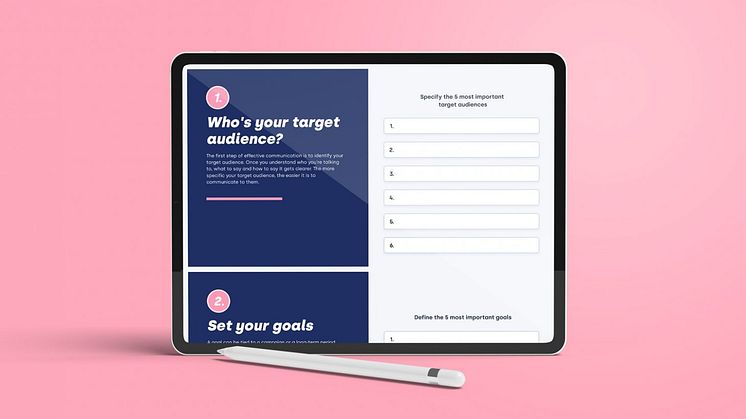
Blog post -
Make the most of your media monitoring in the new year
If you recognize the importance of taking a proactive approach rather than waiting for things to happen and then react, media monitoring is the way to go. Media monitoring helps companies stand in the frontline and stay there. During these unprecedented times, it has been critical to stay informed, however, media monitoring can also help you find new business opportunities if you’re a bit creative.
We’ve made a few suggestions for ways you can benefit from media monitoring this year, perhaps you’ll find new ways to gain coverage?
Monitor your competition.
Through monitoring your prime competitors you will never have to worry about surprises from their side, and you will at the same time be able to plan your next step ahead of them. This is a simple way of making sure that you won’t fall behind in your industry. Knowing what they are up to also helps you see what you are up against. This information can be used for so much more than business intelligence. It can also be a source of creative marketing and communication, as you’ll know how to differentiate your brand from the competition.
Keep an eye on environmental, social, and corporate governance.
There is a reason why The Professional Golfers’ Association (PGA) terminated its plan to use Donald Trump’s Bedminster course in its upcoming American championship. There is also a reason why Deutsche Bank won’t do any more business with the same man. Being associated with certain brands and people can be bad for business, and they have to protect their brand from reputational risk by association.
Keeping an eye out for incidents and buzz involving your subcontractors or partners can help you avoid being associated with unethical practices. Very few brands can afford such associations these days, and with a generally increased focus on ethics, you should look out for your own. This may also lead to the discovery of new potential partners or subcontractors. Or the discovery that your partners are doing something really good, which may benefit you. Who you are associated with will also affect your brand, so make sure you know who you are dealing with.
Use media monitoring for PR and content creation.
Have you run out of content ideas, or don’t know how to get press coverage of that new product you are releasing? Are there any ongoing debates, or perhaps a new trend that has affected other industries, that might affect yours too? Setting up different search profiles for influencers, businesses, or topics outside your traditional sphere of monitoring, can help you find new ideas. You can also read up on what others are writing and talking about.
This gives you insight into what people find entertaining, educational, or simply inspiring. It also gives you insights into what challenges they meet. This is the information you need if you are to find ideas for content and positioning. With a steady flow of information, you can unleash your own creativity and make valuable contributions that will either answer the questions people are asking, entertain, educate or inspire. But also position your brand towards new audiences and industries. Let’s take a closer look at how you do that.
Monitor trends and keywords that your company wants to be associated with.
To find relevant information on the trends and keywords you want information on, or to be associated with, you should follow a few guidelines. One of the most common mistakes companies make when setting up keyword searches, is that the searches are too unspecified. This applies to more traditional monitoring as well, where company or product names can be quite generic. If the keyword you search for carries multiple meanings, or often is used in a different context than the one you are interested in, you may end up with a search profile full of irrelevant information. Eventually, you’ll use up all your mentions before you even get started. Don’t do this.
You want your search profiles to be as precise as possible, so make sure to exclude certain words or phrases your keyword is associated with. One way of getting precise hits is by refining your searches as you go along. This means that you actively monitor the hits you get on your keyword. Exclude irrelevant words and phrases that repeatedly appear in combination with it, and repeat. On the opposite end, add relevant words and phrases you would like to see more of. This way you optimize your search. Taking a proactive approach to your search profiles will give you better and more relevant hits, no matter what trend, keyword, product or brand name you are searching for.
Let’s present a typical example. You are a small B2C company producing energy-efficient chargers for electric cars, and you want to position your brand towards Tesla owners. You won’t see any results by setting up a search for the keyword Tesla. That will only clog your search profile within minutes, as your profile will be full of irrelevant Tesla mentions. You’ll also end up paying more for new mentions, as well as having to spend time refining your search. What you need to do is to specify your search by adding combinations of words that are relevant to you. You could add a new refined search with the words “Tesla”, “charging” and “energy + efficient”. You also need to exclude words such as “Elon Musk”, and the various model names. This will give your profile the right keyword hits, and allow you to find ways to take a relevant position towards your target audience.
Spending a little extra time doing it right from the beginning will help you get the results you are aiming for.
Identify the reasons why your company will be using media monitoring.
This will lead to your monitoring being beneficial rather than anything else. You could just give it a go and start monitoring, but for the tool to be as useful as it can be, what you should do is narrow down the reasons why you will be monitoring. Try defining two or three specific reasons as to what and why you will use the tool, that way your goal will be clear and easier to pursue as well as actually reach. This is a steady step in setting the foundation for an effective strategic program.
Choose the media monitoring tool that covers your needs.
There are many tools available, so where do you begin? Often it makes sense to start with asking yourself these questions:
- What is my budget? There are all sorts of tools available, so you need to make a selection of tools that are available to you, given your budget. Make sure to research whether you will be paying per mention or not, as this might affect the total cost of your acquisition.
- What are my objectives? Going back to the paragraph above, the reason why you monitor will help you make an informed decision on what functionality you need in the tool you pick. If you need to identify and respond to brand mentions, then media monitoring is the way to go. But if you are more concerned with customer conversations, then a social listening tool could give you those insights.
- What sources do I need to monitor? Whether it will be social media, digital or print media, or all of them, you will need to determine what channels to monitor. Will you get the overview you need by covering local sources, or will you also need to monitor global sources? Start with identifying where you tend to get mentions, what channels your target audience use, and where you do business outside of your core market.
- Do I need a fully integrated solution or a tool that has an integration with the other software I use? If you are a small or medium-sized business or organization, with few resources working with marketing and communication, you might want to consider if you are better served with an all-in-one tool that also allows you to perform other parts of your PR work in the same place. This can often be time-saving as it simplifies your work. If you have resources allocated specifically for monitoring, then functionality might be more important than the user-friendliness of the tool.
In total, the main advice to your business in the new year is to take a good look at what you are currently using media monitoring for and see what else there is that you could monitor. Communication can essentially be the crucial point that determines how your company will get by and succeed in the new year. It’s safe to say that great communication leads to great businesses. Make sure that you agree not only in your PR-team but also in your company what your main goals are. If your goals differ from the business goals, you should reconsider them. Expanding to more search profiles and using this technology more actively will provide you with new insights. This could result in several opportunities and possibilities for your company. Also, try not to get overwhelmed by media monitoring and find confidence in the fact that time will let your company know what works and then you can adjust your monitoring from there.
Good luck and happy media monitoring in the new year!


